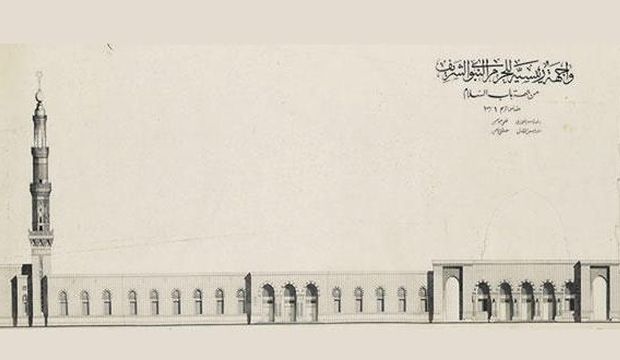
A drawing from the Sotheby’s auction house collection shows a side view of plans to expand the Prophet’s Mosque in Medina, Saudi Arabia. (Asharq Al-Awsat/Courtesy of Sotheby’s)
London, Asharq Al-Awsat—In the Sotheby’s Books & Manuscripts Auction Department there lies an exceptionally rare treasure, a set of priceless documents with a direct connection to an important piece of the Islamic faith’s living history.
The hoard is a complete collection of the architectural plans drawn up by Fahmy Moemen Bey, who was commissioned to design the first extension of the Prophet’s Holy Mosque in Medina, Saudi Arabia. The huge archive, which is to be sold in a private sale by Sotheby’s auction house, contains a large number of original scale drawings, plans and elevations of the extension of the mosque, including 216 photographs that chronicle the construction works ordered by King Abdulaziz Al Saud back in 1951.
The director of Sotheby’s Books Department, Richard Fattorini, said the archive has special historical value because the Prophet’s Mosque, built in 622 CE, became the template for all subsequent examples of Islamic architecture. Fattorini said Moemen Bey sought to preserve existing Ottoman architecture “with the aim of maintaining the old mosque’s spirit and character, so that they remained apparent after the new expansions.”
“To imagine the archive’s size, you can compare it to a full library of a huge project. There are drawings on paper and there are others on huge architect’s linen, which is a special waxed linen [on] which Fahmy Moemen used ink to draw details of the construction, pillars, domes and ceilings,” Fattorini said.
He explains that the advantage of linen was its portability, being easy to carry to different sites of the project so that the taskforce could see the plans and discuss the details. The linen rolls could also be carried to places outside the city, including a mosaic factory that was constructed in the Abar Ali district just outside Medina.
A team of Italian marble craftsmen, having been brought into the Kingdom to help on the project, were not allowed to enter the holy city because they were non-Muslims. Moemen Bey was able to carry the plans to the Italian team in their workshop outside the city to show them the drawings and discuss the engravings and the column bases and heads, as well as details of the window designs and arches.
The archive contains 52 original pen and ink drawings, plans and elevations, and more than 200 photographs that chronicle different stages of the work as well as the detail of decoration, from engravings, bases of pillars and copper capitals, to the tiniest details of internal ceilings and arches.
On the collection’s provenance, Fattorini told Asharq Al-Awsat the archive remained in the possession of Moemen Bey’s family until now. “His family contacted us and notified us of their interest in selling it through Sotheby’s, not at public auction, but through direct contact with the buyer,” Fattorini said. “We should say we are very happy to have had such a unique opportunity.”
The sale is yet to attract attention from prospective buyers as the catalog only came to light a few days ago. According to Fattorini, “it takes time for the catalog to reach people but certainly we have interest from some prospective clients [whom we] are looking forward to showing the drawings to, and maybe [exhibiting] one or two of them as some of them are very large; they range between 1–2.4 meters [1.1–2.6 yards] long.”
The exhibition of the documents is set to open to the public on October 31.
Because the archive will be put up for sale outside public auction, the sold price will remain a secret between Sotheby’s and the buyer. When pushed, Fattorini said only: “We’ve decided not to make the price public, it is something that we can discuss with people who approach us as the archive will not be sold at auction. However, the financial value should necessarily reflect the archive’s spiritual value and importance.”
According to the official website of the Two Holy Mosques, King Abdulaziz Al Saud, having learned in the late 1940s that “people were complaining of the massive crowd during the pilgrimage and minor pilgrimage seasons, and that the mosque could no longer contain all worshipers and visitors, and that some pillars and walls were cracked, he ordered that all necessary measures were taken to accomplish the studies of the construction and expansion of the Prophet’s Holy Mosque.” In an address to Muslims in 1951, the king announced his intention to expand the Prophet’s Holy Mosque, and accordingly, work began in 1951 and continued for five years.
The mosque was re-inaugurated by King Saud Bin Abdulaziz in 1955 after his father’s death. Thanks to the expansion works, there has been a threefold increase in the mosque’s capacity after roughly 13,000 square yards (11,000 square meters) were added to the area, increasing the mosque’s capacity to 28,000 worshipers. Annexes were added to the original mosque in the east and the west, and two minarets were built in the Mamluk style.
Pillar capitals were covered by crowns of yellowish brass adorned with wonderful engravings that were completed in Egypt, where an office was opened to administer and contribute to the expansion project. On top of the crowns there is an adorned square-shaped structure on which four electric lamps are fixed on each side. The lamps are made of yellow copper and glass, styled in delightful shapes. The pillars’ plinths were made of black streaked marble, while the pillars themselves were snow white when first constructed, and remained so for a long time.
